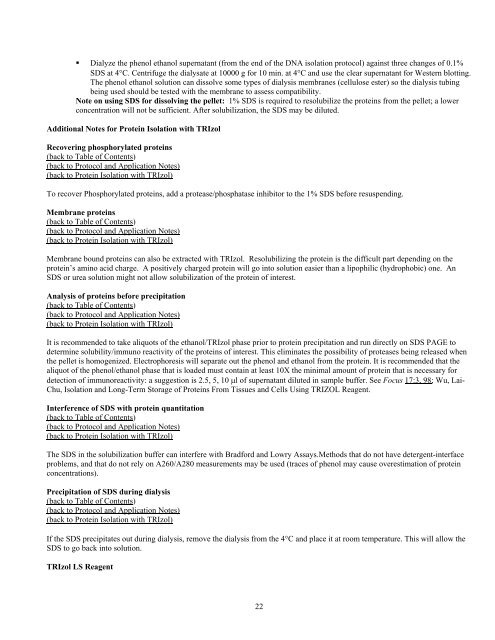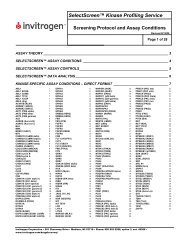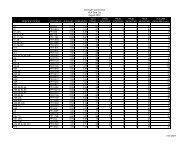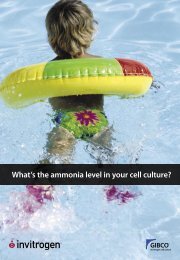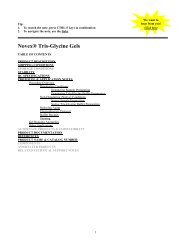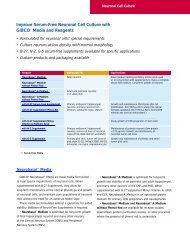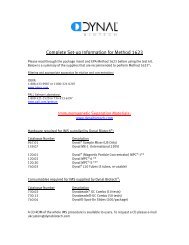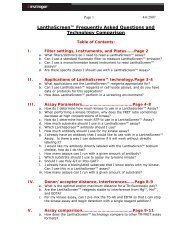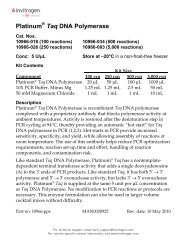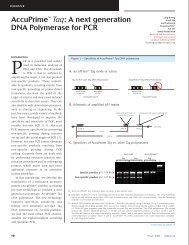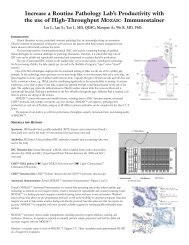TRIzol Reagent - Invitrogen
TRIzol Reagent - Invitrogen
TRIzol Reagent - Invitrogen
Create successful ePaper yourself
Turn your PDF publications into a flip-book with our unique Google optimized e-Paper software.
Dialyze the phenol ethanol supernatant (from the end of the DNA isolation protocol) against three changes of 0.1%<br />
SDS at 4°C. Centrifuge the dialysate at 10000 g for 10 min. at 4°C and use the clear supernatant for Western blotting.<br />
The phenol ethanol solution can dissolve some types of dialysis membranes (cellulose ester) so the dialysis tubing<br />
being used should be tested with the membrane to assess compatibility.<br />
Note on using SDS for dissolving the pellet: 1% SDS is required to resolubilize the proteins from the pellet; a lower<br />
concentration will not be sufficient. After solubilization, the SDS may be diluted.<br />
Additional Notes for Protein Isolation with <strong>TRIzol</strong><br />
Recovering phosphorylated proteins<br />
(back to Table of Contents)<br />
(back to Protocol and Application Notes)<br />
(back to Protein Isolation with <strong>TRIzol</strong>)<br />
To recover Phosphorylated proteins, add a protease/phosphatase inhibitor to the 1% SDS before resuspending.<br />
Membrane proteins<br />
(back to Table of Contents)<br />
(back to Protocol and Application Notes)<br />
(back to Protein Isolation with <strong>TRIzol</strong>)<br />
Membrane bound proteins can also be extracted with <strong>TRIzol</strong>. Resolubilizing the protein is the difficult part depending on the<br />
protein’s amino acid charge. A positively charged protein will go into solution easier than a lipophilic (hydrophobic) one. An<br />
SDS or urea solution might not allow solubilization of the protein of interest.<br />
Analysis of proteins before precipitation<br />
(back to Table of Contents)<br />
(back to Protocol and Application Notes)<br />
(back to Protein Isolation with <strong>TRIzol</strong>)<br />
It is recommended to take aliquots of the ethanol/<strong>TRIzol</strong> phase prior to protein precipitation and run directly on SDS PAGE to<br />
determine solubility/immuno reactivity of the proteins of interest. This eliminates the possibility of proteases being released when<br />
the pellet is homogenized. Electrophoresis will separate out the phenol and ethanol from the protein. It is recommended that the<br />
aliquot of the phenol/ethanol phase that is loaded must contain at least 10X the minimal amount of protein that is necessary for<br />
detection of immunoreactivity: a suggestion is 2.5, 5, 10 µl of supernatant diluted in sample buffer. See Focus 17:3, 98; Wu, Lai-<br />
Chu, Isolation and Long-Term Storage of Proteins From Tissues and Cells Using TRIZOL <strong>Reagent</strong>.<br />
Interference of SDS with protein quantitation<br />
(back to Table of Contents)<br />
(back to Protocol and Application Notes)<br />
(back to Protein Isolation with <strong>TRIzol</strong>)<br />
The SDS in the solubilization buffer can interfere with Bradford and Lowry Assays.Methods that do not have detergent-interface<br />
problems, and that do not rely on A260/A280 measurements may be used (traces of phenol may cause overestimation of protein<br />
concentrations).<br />
Precipitation of SDS during dialysis<br />
(back to Table of Contents)<br />
(back to Protocol and Application Notes)<br />
(back to Protein Isolation with <strong>TRIzol</strong>)<br />
If the SDS precipitates out during dialysis, remove the dialysis from the 4°C and place it at room temperature. This will allow the<br />
SDS to go back into solution.<br />
<strong>TRIzol</strong> LS <strong>Reagent</strong><br />
22


